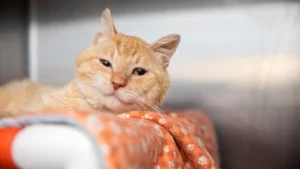Blog
Why Do Cats Always and Not on Mars?
Cats are renowned for their remarkable agility and their uncanny ability to land on their feet after a fall. This fascinating trait has led to the saying, “Cats always land on their feet.” But what happens when we ponder the question, “Why do cats always land on their feet and not on Mars?” This playful twist on a common adage invites us to explore the science behind feline acrobatics, the evolutionary benefits of this skill, and why, despite their impressive abilities, cats have yet to make it to Mars.

The Science Behind Why Cats Always Land on Their Feet
To understand why cats always land on their feet, we need to delve into their unique anatomy and reflexes. This phenomenon, known as the “cat righting reflex,” allows cats to reorient themselves during a fall. Here’s how it works:
1. The Cat Righting Reflex
The cat righting reflex is an innate ability that allows a cat to twist its body in mid-air, ensuring it lands on its feet. This reflex begins to develop in kittens at around three to four weeks of age. By the time they are about six to seven weeks old, most kittens have mastered this skill.
The process involves several key steps:
- Initial Orientation: When a cat begins to fall, it uses its vestibular apparatus (inner ear structure) to sense its orientation relative to the ground.
- Body Adjustment: The cat then uses its flexible spine and powerful muscles to rotate its body. The front half of the cat turns one way while the back half turns in the opposite direction.
- Final Adjustment: Just before landing, the cat extends its legs and prepares to absorb the impact.
2. Flexible Spine and Balance
Cats possess an extraordinarily flexible spine, which plays a crucial role in their ability to land on their feet. The flexibility allows cats to twist their bodies mid-air and adjust their orientation with precision. Additionally, their keen sense of balance, aided by their tail and inner ear structures, helps them maintain control during the fall.

Evolutionary Benefits of Landing on Their Feet
The ability to always land on their feet offers several evolutionary advantages for cats:
1. Survival in the Wild
In their natural habitats, cats often climb trees and other elevated structures to hunt or escape from predators. The ability to land on their feet reduces the risk of injury from falls, increasing their chances of survival. This skill is particularly useful for wild cats who may need to descend quickly from trees or other heights.
2. Increased Mobility
Landing on their feet also enhances a cat’s mobility. The reduced risk of injury allows them to move more freely and confidently, which is essential for hunting, escaping danger, and exploring their environment. This agility contributes to their success as both predators and survivors.
The Myth of Cats on Mars
While the concept of cats landing on Mars is a fun and imaginative twist, it’s important to note that the notion of cats exploring Mars is purely fictional. However, exploring this idea highlights some interesting points about space travel and feline abilities.
1. Gravity Differences
One of the main reasons cats do not land on Mars is the difference in gravity. Mars has only about 38% of Earth’s gravity. If cats were to land on Mars, their righting reflex would be affected by this lower gravity. The reduced gravitational pull would alter the way they fall and land, potentially making their landings less precise compared to what we see on Earth.
2. Environmental Conditions
Mars presents several other challenges for cats, including extreme temperatures, lack of breathable air, and high levels of radiation. These conditions are not suitable for any Earth-based life forms, including cats. The harsh environment would make survival and mobility on Mars incredibly difficult, regardless of their landing abilities.

Fun Facts About Cats and Space
Although cats have not traveled to Mars, they have made their mark in the history of space exploration. Here are a few fun facts about cats and space:
- Félicette the Space Cat: In 1963, a French space program sent a cat named Félicette into space. She became the first and only cat to travel to space, where she orbited the Earth before being safely returned. Félicette’s mission provided valuable data on the effects of space travel on living organisms.
- Cats and Zero Gravity: Scientists have studied how animals, including cats, react to zero gravity. These studies help researchers understand the effects of space travel on different species and contribute to our knowledge of space biology.
The Role of Cats in Popular Culture
Cats have a significant presence in popular culture, often depicted as agile, mysterious, and independent creatures. Their ability to always land on their feet adds to their mystique and appeal. From ancient mythology to modern media, cats have been celebrated for their grace and skill.
1. Mythology and Folklore
In various cultures, cats are seen as symbols of grace and agility. Ancient Egyptians, for example, revered cats and associated them with the goddess Bastet, who was depicted with feline features. The cat’s ability to always land on its feet further enhances their reputation as mystical and skilled creatures.
2. Modern Media
Cats frequently appear in movies, books, and cartoons, often showcasing their remarkable agility and charm. Characters like Garfield and the Cheshire Cat highlight the playful and endearing nature of felines, reinforcing the fascination with their abilities.

Conclusion
In conclusion, the ability of cats to always land on their feet is a remarkable feat of nature, showcasing their agility, flexibility, and survival instincts. While the whimsical idea of cats landing on Mars is a playful concept, it serves to emphasize the unique adaptations that make cats exceptional creatures. Their righting reflex, combined with their evolutionary benefits, allows cats to navigate their world with grace and precision.
The question “Why do cats always land on their feet and not on Mars?” invites us to appreciate the incredible abilities of these beloved animals while acknowledging the limits imposed by their natural environment. Whether on Earth or in the realm of imagination, cats continue to captivate and inspire with their agility and charm.
